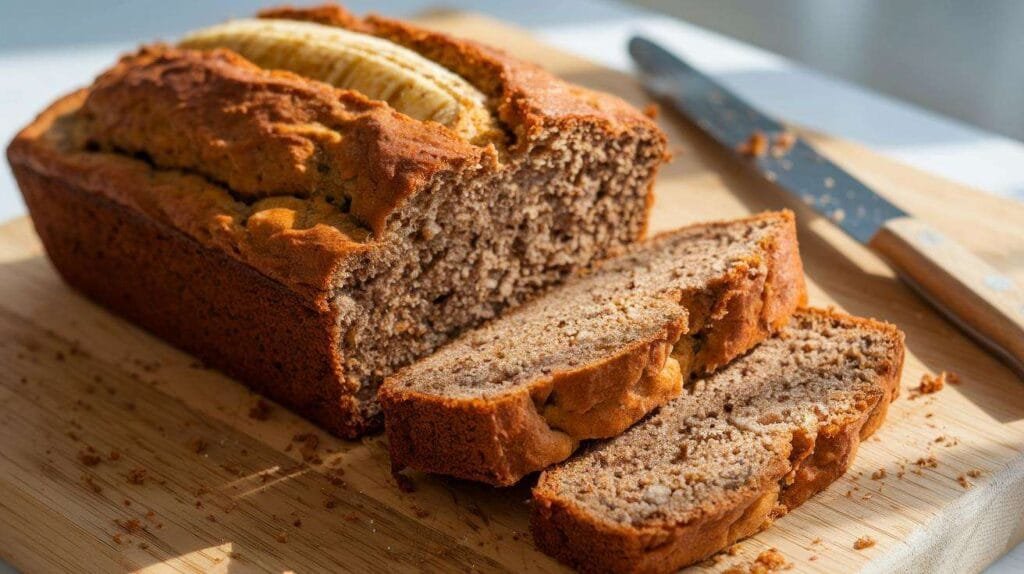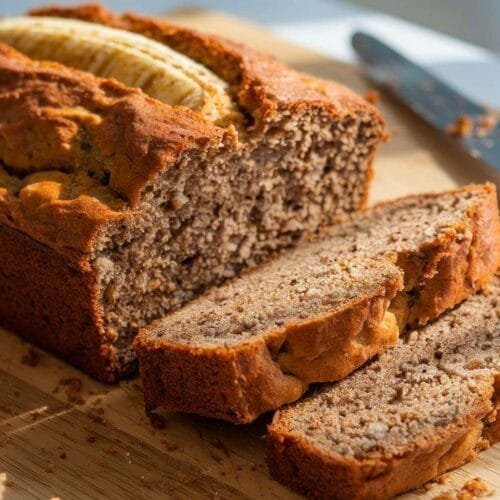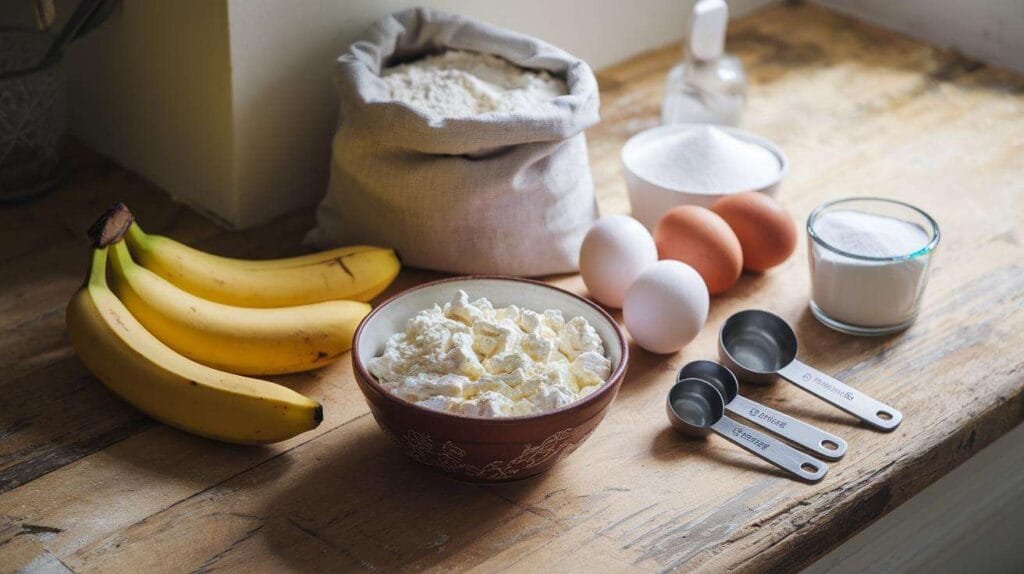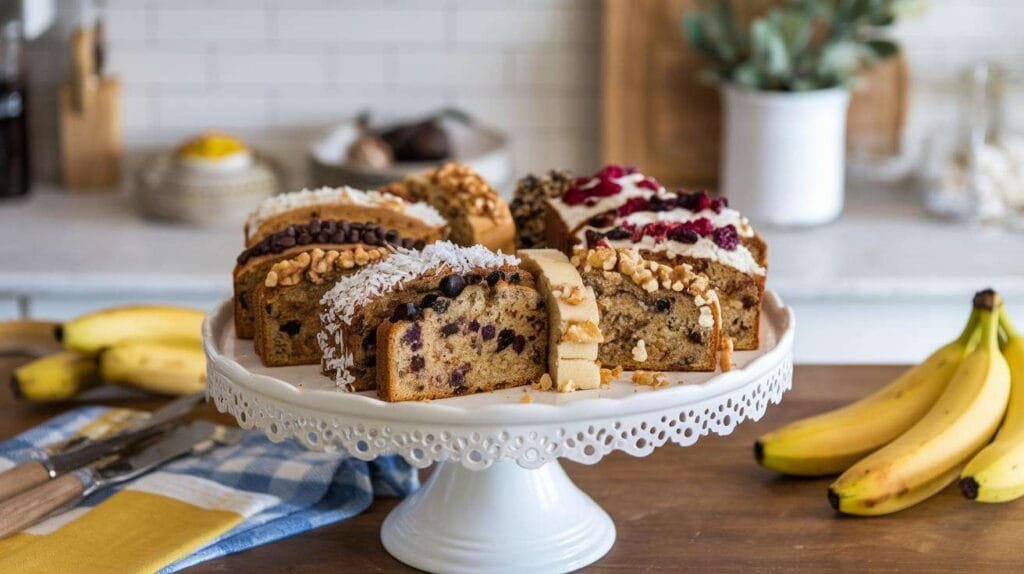Imagine the comforting aroma of freshly baked banana bread wafting through your home. Now, take that experience to the next level with a secret ingredient: cottage cheese. Yes, cottage cheese! It might sound unusual, but trust me, it’s a game-changer. Whether you’re a seasoned baker or just starting out, this recipe will have you excited to whip out your mixing bowls and try something new. So, let’s dive into what makes this cottage cheese banana bread recipe truly special.
Why Cottage Cheese is a Game-Changer in Banana Bread
Banana bread is already a beloved classic—simple to bake, delicious to eat, and endlessly versatile. But have you ever thought of taking it up a notch with cottage cheese? This humble ingredient, as detailed in our cottage cheese and eggs recipe, adds unparalleled creaminess and nutritional value. Whether you’re baking or crafting a hearty breakfast, cottage cheese proves to be a game-changer in countless ways.

Benefits of Using Cottage Cheese in Baking
Cottage cheese is like the underdog of the dairy aisle. While it doesn’t always get the spotlight, it brings a lot to the table—especially in baking. For starters, it’s packed with protein, which adds a nutritional boost to your baked goods. This is particularly useful if you’re trying to make your banana bread a little healthier without sacrificing taste. Plus, cottage cheese has a natural creaminess that enhances the texture of the bread, making it incredibly moist and soft.
How Cottage Cheese Enhances Banana Bread’s Texture
Achieving the perfect texture in banana bread can feel like a delicate balancing act. A too-wet batter might result in a soggy loaf, while insufficient moisture leaves it dry and crumbly. Here’s where cottage cheese steps in to save the day. Similar to its role in our buttermilk cake recipe, it blends seamlessly into the batter, ensuring a moist, tender crumb that melts in your mouth.
Cottage Cheese Banana Bread Recipe
Now that you’re convinced of cottage cheese’s superpowers, let’s talk ingredients. A good banana bread recipe is all about balance—flavors, textures, and even health benefits. Here’s everything you’ll need to create this moist and delicious masterpiece.

Cottage Cheese Banana Bread
Equipment
- Mixing bowl
- Loaf pan
- Whisk
- Spatula
- Oven
Ingredients
- 3 ripe bananas mashed
- 1/2 cup cottage cheese
- 2 eggs beaten
- 1/4 cup honey
- 1 teaspoon vanilla extract
- 1 1/2 cups whole wheat flour
- 1 teaspoon baking soda
- 1/2 teaspoon cinnamon
- 1/4 teaspoon salt
Instructions
Prepare the Batter:
- Preheat oven to 350°F (175°C). Grease a loaf pan.
- In a mixing bowl, mash the bananas. Add cottage cheese, eggs, honey, and vanilla extract. Mix until well combined.
Mix Dry Ingredients:
- In a separate bowl, whisk together whole wheat flour, baking soda, cinnamon, and salt.
Combine and Bake:
- Gradually add the dry ingredients to the wet ingredients, stirring until just combined.
- Pour the batter into the prepared loaf pan and bake for 50 minutes, or until a toothpick inserted comes out clean.
Cool and Serve:
- Allow the banana bread to cool before slicing and serving.

Common Mistakes to Avoid
Even the best bakers can make a misstep or two. Let’s look at some common mistakes and how to avoid them, so your cottage cheese banana bread comes out perfect every time.
The Number One Mistake in Banana Bread Recipes
Hands down, the biggest mistake is using under-ripe bananas. Bananas that are too firm don’t mash well, which means you won’t get that intense banana flavor. Always opt for bananas with plenty of brown spots—this is their sweet spot (literally).
Overmixing and Its Effects on Texture
Overmixing might seem harmless, but it’s one of the quickest ways to ruin banana bread. The more you mix, the more gluten develops in the flour. While gluten is great for bread like sourdough, it makes quick breads like banana bread chewy and dense. Remember, a gentle hand is key!
Measuring Ingredients Accurately
Baking is a science, and precision matters. Use measuring cups for dry ingredients and a liquid measuring cup for wet ones. Level off your flour with a knife, and don’t eyeball the sugar—it’s tempting, but trust me, you’ll thank yourself later.
Creative Twists on Classic Banana Bread
Let’s face it: the beauty of banana bread lies in its versatility. While the traditional recipe is undeniably delicious, there’s so much room for creativity. If you’re looking to shake things up, these variations will inspire you to experiment and have fun in the kitchen.
Why Almond Flour is a Game-Changer
If you’ve never baked with almond flour before, you’re in for a treat. It’s not only naturally gluten-free but also rich in nutrients like Vitamin E and healthy fats. Adding almond flour to your banana bread creates a slightly nutty flavor while keeping the loaf moist. Plus, it’s a great alternative for those avoiding refined flours.
But here’s the trick: almond flour behaves a bit differently than traditional flour. It’s denser and doesn’t rise as much, so you’ll need to make some adjustments. For example, using a bit more baking powder (around 1 ½ teaspoons for 2 cups of almond flour) will help give your bread a nice lift. Also, adding an extra egg can provide additional structure to prevent the bread from crumbling.
On-the-Go Goodness with Banana Muffins
If you’re someone who’s always rushing out the door, muffins are the perfect solution. Turning banana bread into muffins isn’t just practical—it’s downright genius. They’re portable, easy to share, and bake faster than a loaf. To make them, simply divide your batter into a muffin tin lined with paper cups. Bake them at 350°F for 20–25 minutes, and you’ve got a batch of delicious banana cottage cheese muffins that are perfect for breakfast, snacks, or even dessert.
Pairing Bananas and Cottage Cheese with Other Flavors
Looking to add some excitement to your banana bread? Incorporating ingredients like:
- Dark Chocolate Chips: Can add richness without overshadowing the banana’s natural sweetness. For an extra crunch, try folding in nuts like walnuts or pecans. If you’re a fan of desserts with layers of flavor, like our orange zest low-carb dessert, this variation will quickly become
- Walnuts or Pecans: These bring a satisfying crunch and complement the creamy cottage cheese beautifully.
- Dried Cranberries or Raisins: For a subtle tangy-sweet twist, mix in a handful of dried fruits.
- Shredded Coconut: Sprinkle some on top before baking for a tropical vibe.
These small additions can take your banana bread from simple to stunning in no time. Don’t be afraid to experiment and make the recipe truly yours.

How Healthy is Banana Bread?
There’s no denying that banana bread feels like a treat, but it can also be surprisingly healthy if done right. Let’s break down the nutritional benefits and look at how you can make this comfort food even better for you.
Balancing Taste and Nutrition
Cottage cheese lends banana bread an undeniable edge—not just for its creamy texture but also for its impressive nutrition. Packed with protein and lower in fat compared to alternatives like cream cheese, it enhances the loaf’s flavor and makes it more satisfying. Much like the cheeses featured in our guide to grated cheese types, uses, and benefits, cottage cheese strikes a perfect balance between taste and health.
For those watching their sugar intake, reducing the amount of added sugar is easy. The natural sweetness of ripe bananas often means you can cut back on sugar by half without compromising on flavor. Better yet, swap out refined sugar for honey or maple syrup for a more natural option.
Can You Enjoy Banana Bread While Losing Weight?
Absolutely! The key is moderation and making smart substitutions. By using almond flour or whole wheat flour, reducing the sugar, and relying on cottage cheese for moisture, you can create a version that’s both satisfying and waistline-friendly. Pair it with a cup of coffee or tea, and you’ve got yourself a guilt-free treat.
Baking Tips for Almond Flour Recipes
Working with almond flour is a bit different than traditional flour, but don’t worry—it’s easier than you think. If you’re planning to make cottage cheese almond flour bread, these tips will ensure your loaf turns out perfectly every time.
How Much Baking Powder Do You Really Need?
Since almond flour is heavier than all-purpose flour, you’ll need a bit more leavening agent to help it rise. As a rule of thumb, use 1 ½ teaspoons of baking powder for every 2 cups of almond flour. This creates the perfect balance, giving your bread enough lift without making it overly dense.
The Trick to Baking with Almond Flour
Almond flour tends to brown faster than traditional flour due to its higher fat content. To prevent your bread from over-browning, cover the top with foil during the last 10–15 minutes of baking. This keeps the loaf golden without drying it out.
Another tip? Don’t overmix the batter. Almond flour is delicate, and too much mixing can lead to a grainy texture. Use a light hand, and mix just until everything is combined.
The Art of Perfect Banana Bread
Perfecting banana bread is as much about the little details as it is about the big picture. From choosing the right ingredients to nailing the baking time, every step plays a role. And don’t forget—mistakes are part of the process. Even if your first loaf isn’t perfect, you’ll learn and improve with every try.
Want to get more creative? Add a sprinkle of sea salt on top for contrast, or drizzle your cooled loaf with a simple glaze made of powdered sugar and lemon juice. The possibilities are endless, and that’s the beauty of this timeless treat.
FAQs
Baking isn’t just about following a recipe—it’s about understanding the ingredients and techniques that bring everything together. Below, we’ll tackle some of the most common questions and concerns people have when working with cottage cheese, almond flour, and banana bread in general. These insights will help you feel more confident in the kitchen.
What Does Cottage Cheese Do in Baking?
Cottage cheese plays multiple roles in baking. Its high protein content improves the structure of baked goods, making them more tender and moist. It’s also a great substitute for higher-fat ingredients like cream or sour cream, which makes it an excellent option for lighter recipes. In banana bread specifically, cottage cheese blends seamlessly into the batter, ensuring that each bite is soft without being soggy. Plus, it adds a slight tang that complements the sweetness of the bananas beautifully.
What Is the Number One Mistake Made When Making Banana Bread?
If you’ve ever ended up with banana bread that’s either too dense or too dry, you’re not alone. The number one mistake people make is overmixing the batter. When you mix too much, the gluten in the flour develops, leading to a tough texture. Remember, banana bread isn’t like traditional bread—gentle folding is all you need.
Another common mistake? Not using ripe bananas. They should be heavily speckled with brown spots for maximum sweetness and flavor. If your bananas aren’t quite there yet, try microwaving them for 30 seconds to soften and release their sugars.
Can I Eat Banana Bread While Losing Weight?
Yes, you absolutely can enjoy banana bread while working toward your health goals. The key is portion control and smart ingredient swaps. For instance, you can:
- Replace all-purpose flour with almond flour to lower the carbs and increase healthy fats.
- Use cottage cheese for added protein and moisture instead of high-calorie ingredients like heavy cream.
- Reduce the sugar or replace it with natural sweeteners like stevia or monk fruit.
Pair a slice of banana bread with a side of Greek yogurt or a handful of nuts for a balanced snack that keeps you full longer.
How Much Baking Powder for 2 Cups of Almond Flour?
When working with almond flour, you’ll need to adjust your leavening agents slightly. For every 2 cups of almond flour, 1 ½ teaspoons of baking powder is a good starting point. Almond flour is denser than traditional flour, so this extra lift ensures your bread rises properly. If you’re using baking soda instead of baking powder, remember to include an acid like yogurt or lemon juice to activate it.
What Is the Trick to Baking with Almond Flour?
Baking with almond flour can feel a bit intimidating at first, but once you understand its quirks, it’s a breeze. Here are some tips to keep in mind:
- Don’t Pack the Flour: Almond flour tends to clump, so fluff it with a fork before measuring. Always spoon it into your measuring cup and level it off for accuracy.
- Watch the Bake Time: Because almond flour browns faster, keep an eye on your bread as it bakes. Cover the loaf with foil if it’s browning too quickly.
- Add Extra Binding Agents: Eggs are your best friend when baking with almond flour, as they help bind the ingredients and give your bread structure. If you’re using flaxseed or chia as an egg substitute, make sure to add an extra tablespoon of water to maintain moisture.
Experimenting with Recipes
Experimentation is the heart of great baking. Whether you’re incorporating new ingredients like cottage cheese or exploring alternative flours for a gluten-free twist, the possibilities are endless. For example, take inspiration from our Nestlé chocolate chips recipe, where balance and creativity yield exceptional results. Remember, the joy of baking lies in the process—messes included!
If you’re new to baking or feeling hesitant about trying variations, start with small changes. Maybe replace half the flour with almond flour in your next loaf, or swap out the sugar for honey. Each adjustment teaches you something new and brings you closer to creating a recipe that feels uniquely yours.

